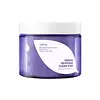What's inside
What's inside
 Key Ingredients
Key Ingredients

 Benefits
Benefits

 Concerns
Concerns

No concerns
 Ingredients Side-by-side
Ingredients Side-by-side

Water
Skin ConditioningMethylpropanediol
Solvent1,2-Hexanediol
Skin ConditioningCitrus Aurantifolia Fruit Extract
Skin ConditioningSolanum Melongena Fruit Extract
Skin ConditioningCentella Asiatica Extract
CleansingCalendula Officinalis Extract
Skin ConditioningMelaleuca Alternifolia Leaf Extract
PerfumingGaultheria Procumbens Leaf Extract
PerfumingGlyceryl Caprylate
EmollientAllantoin
Skin ConditioningTrehalose
HumectantBetaine
HumectantGardenia Jasminoides Fruit Extract
Cosmetic ColorantTromethamine
BufferingButylene Glycol
HumectantCitric Acid
BufferingBetula Platyphylla Japonica Juice
Skin ConditioningLactic Acid
BufferingGlycolic Acid
BufferingDipropylene Glycol
HumectantSalicylic Acid
MaskingSodium Hyaluronate
HumectantGlycyrrhiza Glabra Root Extract
BleachingCitrus Aurantium Dulcis Fruit Extract
MaskingVitis Vinifera Fruit Extract
Skin ConditioningPyrus Malus Fruit Extract
Skin ConditioningCitrus Limon Fruit Extract
MaskingEthyl Hexanediol
SolventAlcohol
AntimicrobialPolyglyceryl-10 Laurate
Skin ConditioningEthylhexylglycerin
Skin ConditioningDextrin
AbsorbentDisodium EDTA
Ammonium Acryloyldimethyltaurate/Vp Copolymer
Water, Methylpropanediol, 1,2-Hexanediol, Citrus Aurantifolia Fruit Extract, Solanum Melongena Fruit Extract, Centella Asiatica Extract, Calendula Officinalis Extract, Melaleuca Alternifolia Leaf Extract, Gaultheria Procumbens Leaf Extract, Glyceryl Caprylate, Allantoin, Trehalose, Betaine, Gardenia Jasminoides Fruit Extract, Tromethamine, Butylene Glycol, Citric Acid, Betula Platyphylla Japonica Juice, Lactic Acid, Glycolic Acid, Dipropylene Glycol, Salicylic Acid, Sodium Hyaluronate, Glycyrrhiza Glabra Root Extract, Citrus Aurantium Dulcis Fruit Extract, Vitis Vinifera Fruit Extract, Pyrus Malus Fruit Extract, Citrus Limon Fruit Extract, Ethyl Hexanediol, Alcohol, Polyglyceryl-10 Laurate, Ethylhexylglycerin, Dextrin, Disodium EDTA, Ammonium Acryloyldimethyltaurate/Vp Copolymer
Allium Cepa Bulb Extract
Skin ConditioningButylene Glycol
HumectantGlycerin
HumectantWater
Skin Conditioning1,2-Hexanediol
Skin ConditioningNiacinamide
SmoothingHouttuynia Cordata Extract
Skin ConditioningSodium Heparin
Skin ConditioningPanthenol
Skin ConditioningAllantoin
Skin ConditioningTrehalose
HumectantSodium Hyaluronate
HumectantHydrolyzed Hyaluronic Acid
HumectantSodium Acetylated Hyaluronate
HumectantBeta-Glucan
Skin ConditioningTranexamic Acid
AstringentSodium Ascorbyl Phosphate
AntioxidantGluconolactone
Skin ConditioningHydroxyethylcellulose
Emulsion StabilisingAdenosine
Skin ConditioningMelia Azadirachta Flower Extract
Skin ConditioningCoccinia Indica Fruit Extract
Skin ConditioningCitric Acid
BufferingEthylhexylglycerin
Skin ConditioningAllium Cepa Bulb Extract, Butylene Glycol, Glycerin, Water, 1,2-Hexanediol, Niacinamide, Houttuynia Cordata Extract, Sodium Heparin, Panthenol, Allantoin, Trehalose, Sodium Hyaluronate, Hydrolyzed Hyaluronic Acid, Sodium Acetylated Hyaluronate, Beta-Glucan, Tranexamic Acid, Sodium Ascorbyl Phosphate, Gluconolactone, Hydroxyethylcellulose, Adenosine, Melia Azadirachta Flower Extract, Coccinia Indica Fruit Extract, Citric Acid, Ethylhexylglycerin
 Reviews
Reviews

Ingredients Explained
These ingredients are found in both products.
Ingredients higher up in an ingredient list are typically present in a larger amount.
1,2-Hexanediol is a synthetic liquid and another multi-functional powerhouse.
It is a:
- Humectant, drawing moisture into the skin
- Emollient, helping to soften skin
- Solvent, dispersing and stabilizing formulas
- Preservative booster, enhancing the antimicrobial activity of other preservatives
Allantoin is a soothing ingredient known for its protective and moisturizingg properties. Because of this, it is often added to products with strong active ingredients.
Studies show higher concentrations of this ingredient can promote wound healing.
Though it can be derived from the comfrey plant, allantoin is produced synthetically for cosmetic products to ensure purity.
Learn more about AllantoinButylene Glycol (or BG) is used within cosmetic products for a few different reasons:
Overall, Butylene Glycol is a safe and well-rounded ingredient that works well with other ingredients.
Though this ingredient works well with most skin types, some people with sensitive skin may experience a reaction such as allergic rashes, closed comedones, or itchiness.
Learn more about Butylene GlycolCitric Acid is an alpha hydroxy acid (AHA) naturally found in citrus fruits like oranges, lemons, and limes.
Like other AHAs, citric acid can exfoliate skin by breaking down the bonds that hold dead skin cells together. This helps reveal smoother and brighter skin underneath.
However, this exfoliating effect only happens at high concentrations (20%) which can be hard to find in cosmetic products.
Due to this, citric acid is usually included in small amounts as a pH adjuster. This helps keep products slightly more acidic and compatible with skin's natural pH.
In skincare formulas, citric acid can:
While it can provide some skin benefits, research shows lactic acid and glycolic acid are generally more effective and less irritating exfoliants.
Most citric acid used in skincare today is made by fermenting sugars (usually from molasses). This synthetic version is identical to the natural citrus form but easier to stabilize and use in formulations.
Read more about some other popular AHA's here:
Learn more about Citric AcidEthylhexylglycerin (we can't pronounce this either) is commonly used as a preservative and skin softener. It is derived from glyceryl.
You might see Ethylhexylglycerin often paired with other preservatives such as phenoxyethanol. Ethylhexylglycerin has been found to increase the effectiveness of these other preservatives.
Sodium Hyaluronate is hyaluronic acid's salt form. It is commonly derived from the sodium salt of hyaluronic acid.
Like hyaluronic acid, it is great at holding water and acts as a humectant. This makes it a great skin hydrating ingredient.
Sodium Hyaluronate is naturally occurring in our bodies and is mostly found in eye fluid and joints.
These are some other common types of Hyaluronic Acid:
Learn more about Sodium HyaluronateTrehalose is a disaccharide made of two glucose molecules (glucose is sugar!). Trehalose is used to help moisturize skin. It also has antioxidant properties.
As a humectant, trehalose helps draw moisture from the air to your skin. This helps keep your skin hydrated.
Due to its antioxidant properties, trehalose may help with signs of aging. Antioxidants help fight free-radical molecules, unstable molecules that may damage your skin.
In medicine, trehalose and hyaluronic acid are used to help treat dry eyes.
Some animals, plants, and bacteria create trehalose as a source of energy to survive freeze or lack of water.
Learn more about TrehaloseWater. It's the most common cosmetic ingredient of all. You'll usually see it at the top of ingredient lists, meaning that it makes up the largest part of the product.
So why is it so popular? Water most often acts as a solvent - this means that it helps dissolve other ingredients into the formulation.
You'll also recognize water as that liquid we all need to stay alive. If you see this, drink a glass of water. Stay hydrated!
Learn more about Water